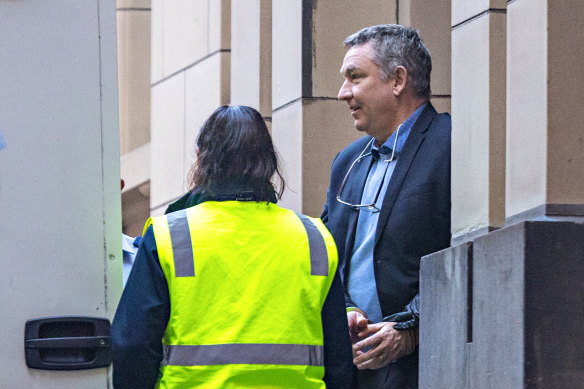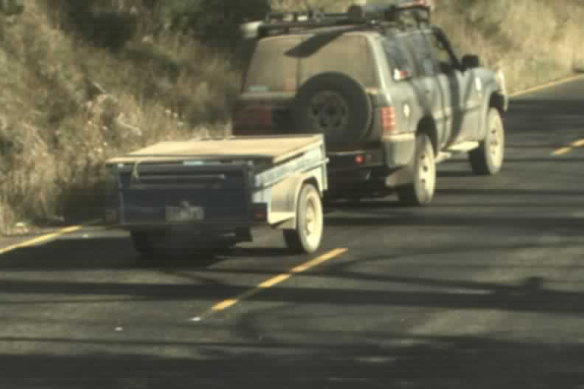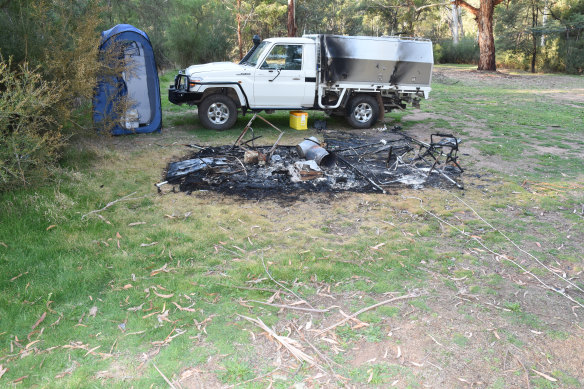A trial is always about what happens in the court, not what happened at the crime scene. Which means a jury of six men and six women in the Supreme Court spent seven days deciding what happened 346 kilometres away and 1558 days earlier.
(There had been a plan to take the murder jury to the crime scene on a giant army Chinook helicopter, but it was deemed to be too expensive.)
There was only one eyewitness and he was the defendant – Greg Lynn – charged with the murders of campers Carol Clay and Russell Hill. The jury found him guilty of Clay’s murder and not guilty of Hill’s.
It is a huge endorsement of the jury system that 12 people would study the evidence so closely to deliver a split decision, choosing not to blindly accept either the versions presented by the defence or the prosecution. They were more rigorous than that.
On hearing the verdict Lynn showed no emotion, which is not surprising. He was a commercial airline pilot. They are selected only after rigorous psychological testing shows they have logical and ordered minds and then trained to remain calm in potentially catastrophic circumstances. This is why when a pilot loses an engine they go to the book, not the parachute.
Lynn may be a strange man who did strange things, but that does not make him a murderer.
The prosecution was based on logic. The defence on Lynn’s sworn testimony. The prosecution said Lynn’s case was based on lies. The defence said the prosecution was guessing.
A strong case can be based on independent eyewitnesses (human and electronic), crime scene evidence, pathology reports and admissions from the accused.
Clockwise from left: A sketch of the Bucks Camp site Gregory Lynn drew for police; Lynn; Carol Clay; and Russell Hill.
The Lynn case had none of the above. The prosecution could not prove how the couple died because Lynn had dumped, burned and pulverised the bodies, and police were unable to gather vital evidence from the scene as Lynn had burned the site.
What was agreed was that Lynn had a confrontation with Hill at a remote campsite. That Hill, 74, and Clay, 73, died violently and that Lynn destroyed the crime scene, left clues to make it look like it could be a robbery and hid the bodies.
The prosecution said Lynn shot them then destroyed evidence and hid the bodies because he was a murderer.
The defence said Lynn was present when they died, panicked, then destroyed evidence and hid the bodies because he believed police would think he was a murder. This scenario goes against all of Lynn’s training. All flight staff are taught to self report any possible mistakes. “It is drilled into us,” says one experienced flight staff.
When the judge removed the option of finding Lynn guilty of the lesser charge of manslaughter it appeared the jury would have to find Lynn guilty of two murders or set him free.
They did neither.
Loading
They found a third version – one that was not put to them in open court. Rather than choose to side with the prosecution or the defence, the jury reviewed Lynn’s evidence and testimony from a ballistic expert to analyse Lynn’s claim Clay was accidentally shot.
It would appear the jury concluded that Hill was killed in unprovable circumstances, but Lynn then murdered Clay because she was a witness to the death. With the option of manslaughter off the table the jury had to conclude whether Hill was murdered – a deliberate act – not just unlawfully killed – a reckless act.
With no forensic evidence, it was impossible for the jury to establish the exact circumstances of Hill’s death, but they apparently concluded it was so damning that Lynn chose to kill Clay and destroy the crime scene in the cover-up.
In his police interview Lynn said: “I’m not a bad person.” Yet he admitted he acted despicably. But does this mean he is a murderer?
Lynn says that on March 20, 2020, while camping at Dry River Creek Road (also known as Bucks Camp) in the Wonnangatta Valley, he had a dispute with Hill that led to the older man leaning into Lynn’s car to grab a shotgun.
The two men fought over the gun, Lynn says, with Hill’s finger on the trigger when it accidentally discharged, hitting Clay in the head while she crouched down on the passenger side of Hill’s white Toyota LandCruiser ute, with the shot deflecting off the vehicle’s external mirror.
Realising Clay was dead, Hill attacked Lynn with a knife, fell on his blade, causing a fatal chest wound.
It is unusual for a random shot to hit someone hiding from the line of fire. It is even more unusual for a ricocheted solid shot to hit someone in the head, killing them instantly. We contacted a respected mathematician asking for a calculation of the odds. He said the variables made it impossible to be accurate, but it was “wildly improbable”.
“As a general proposition people do not die from a single stab wound to the chest …”
To put this in perspective: In another case where a woman was shot allegedly after a gun was dropped the probability was one in 160 billion. But the question for the jury was not that it was improbable but whether it was possible. They found that it was not.
It is even more unusual for an accidental self-inflicted stabbing wound to avoid the ribs and breastbone to create a fatal wound. Again, the jury had to decide if it was possible. They found it was impossible to establish what happened and acquitted Lynn on this count.
According to Lynn, Hill died instantly. A senior pathologist not involved in this case said: “As a general proposition people do not die from a single stab wound to the chest unless it triggers an underlying condition such as heart disease.”
If either Clay or Hill lingered, Lynn would have been duty bound to call for help but if they were dead his actions from that point were about self-preservation. He couldn’t save them so he may as well save himself.
Loading
There is something else that is unusual. Lynn gave sworn evidence opening himself to cross-examination. Usually, the accused stays silent. Lynn was the only defence witness.
The defence considered calling character witnesses to show that Lynn was a good egg. But the Crown would have wanted to call rebuttal witnesses including the parents of his first wife, Lisa. They would have testified about her mysterious death in 1999 and how she was terrified of Lynn.
They could have given evidence of how Lynn had beheaded the family’s pet miniature pig in a fit of rage and left it on the doorstep for Lisa to find, and how the next door neighbour’s dog that had annoyed Lynn was found dead and strung up on their fence.
And how Lynn taunted them over the fact that although he was estranged from Lisa he had inherited the house she bought before they were married.

Lynn is taken from the court after the verdicts.Credit: Jason South
Lynn’s evidence was impressive. He was quietly spoken and calm. Depending on your views, his calmness didn’t align with his version that he panicked. The other is he was calm because he was telling the truth.
In a criminal trial, the defence doesn’t have to prove anything. It only has to establish the prosecution has not proven its case. The prosecution is the lead actor in the play and the defence is the heckler in the audience.
The prosecution has to convince the jury there is no other reasonable alternative to the case they have submitted.
The prosecution said two accidental deaths in minutes at the same spot was so improbable it should be discounted. They claimed Lynn’s methodical destruction of the crime scene and the disposal of the bodies was not consistent with a person gripped by panic.
But human nature is not a predictable science. Calm people panic, brave people run away, timid people fight if cornered and smart people do dumb things.
Loading
The defence said the prosecution produced nothing to disprove Lynn’s testimony, but the jury would have wrestled with a number of questions.
Why would an experienced shooter and risk-averse pilot leave firearms and ammunition in plain sight in an open car? Why, after the pyjama-clad Hill fired a shot in the air, did the “scared shitless” Lynn not seek safety in the dark bush?
Why did Lynn choose to move 70 metres (that is the distance from MCG centre circle to the goal square) over unprotected space from his camp to where Hill took the gun to the couple’s camp to grapple with Hill over the loaded firearm? Why after the initial fight for the firearm that left Clay dead did Lynn choose to fire the gun to make sure it was empty rather than remove the magazine?
Why didn’t Lynn keep possession of the loaded gun to protect himself from further attack and why would Hill, who hated guns (telling others a relative had been shot in a hunting accident) grab, load and fire a shotgun over a claim Lynn was playing his music too loudly?
The jurors may have asked why Hill would take such drastic action that was likely to involve police intervention, exposing his secret affair with Carol Clay. And how could Lynn see the “flashing” steel of the knife Hill used to attack him in the dark?
March 20, 2020, was a sunny, mild day but from 6pm the clouds rolled in and at night there was a waning moon, which left it 88 per cent in darkness.
When Lynn set fire to the crime scene he removed the external mirror from Hill’s car and threw it into the blaze. This would indicate it was evidence and had been hit by a shot but not the way Lynn said in his evidence.
The police theory (and it is only a theory) is that when Hill and Clay arrived at the campsite Lynn had already set up at the best spot, a private area with access to the river. The annoyed Hill would have walked through the prime spot to get water, raising tension between the two men – both of whom had a history of wanting to win any argument.
Later Lynn, who walked around the bush in camouflage gear as if about to go on safari, was buzzed by Hill’s hovering drone. “Pilots hate drones,” a detective said.
The drone has not been found.
There were three twists of fate that led to Lynn being charged and the remains being found. Once police knew he was the only suspect, they began a media campaign to put pressure on Lynn.
Lynn’s planned route to where he intended to dispose of the bodies was blocked by a temporary sign as the road was closed because of the fear of falling trees from the summer’s bushfires. He was forced to turn back and find another way out. Police say if the original route through the wilderness was open he could have disposed of the remains and slipped back unnoticed.

Lynn’s vehicle was caught on camera after he was forced to take an alternative route to dispose of the bodies.Credit: Supreme Court of Victoria
On the non-preferred route Lynn was forced to take, Hill’s phone pinged at the time and location where Lynn’s vehicle was photographed near the Hotham Alpine Resort by an Automatic Number Plate Recognition camera. That was the vital link.
As a COVID project, Lynn bought a bee hive. When he was stung, he suffered an allergic reaction that put his heart out of rhythm and required strong medication.
This left the pilot unfit for flying, and he was assigned to simulation training.
If he were still flying, police would have been forced to alert Jetstar of their concerns over Lynn flying hundreds of passengers around Australia. This would have alerted him that he was the suspect and foiled the police strategy of building pressure.
Senior defence barrister Dermot Dann, KC, told the jury his client had answered 1200 police questions without lying and provided more than 1000 pieces of information that turned out to be true.
That is not entirely accurate. Much of the interview, in which he lied, was ruled inadmissable and not presented to the jury.
Loading
In an earlier interview with Lynn at his home in July 2021, he admitted being at the campsite but claimed it was a day earlier and that he had not seen or spoken to the couple. “I didn’t come across them on my trip,” Lynn lied.
A police officer secretly recorded the conversation and the judge ruled it was inadmissible because he should have been cautioned as a suspect.
When he was arrested in November and taken to the Sale police station he began by feigning ignorance: “Why am I here?”
In between “no comment” answers he said his original statement was true – he had not seen them. His lawyer tells him not to talk, but he continues to leave the door open and police continue to press.
He is asked 2944 questions. It is not until question 1691 he says: “I am going to ignore my solicitor’s advice and tell you what happened right from scratch.”
From there he tells the version he presented in court. That he didn’t kill the couple but panicked because he didn’t think anyone would believe him. He got that part right.

The burnt Bucks Camp crime scene.
Much of the prosecution case was thrown out by Justice Michael Croucher before the trial as contrary to the rules of evidence. Were the police tactics wrong? Not really. The first aim was to find the remains of the victims and return them to their families, and without Lynn’s arrest and interview that would have never happened.
And we would all still be wondering.
After the legal judgments, police tactics and courtroom rhetoric only one person knows what happened at that remote camp on March 20, 2020. That is Greg Lynn, who will now be in his cell reflecting on the jury’s decision.
As Lynn is expected to appeal, the long and winding journey from Bucks Camp to the Supreme Court may not yet be over.
John Silvester lifts the lid on Australia’s criminal underworld. Subscribers can sign up to receive his Naked City newsletter every Thursday.

